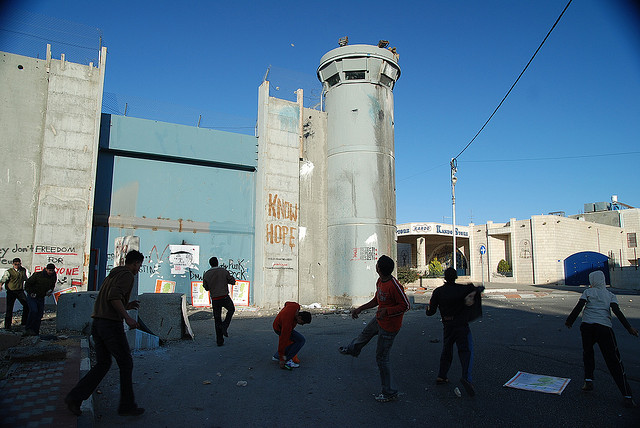Al Jazeera English, 26 July 2014
In the West Bank’s largest demonstration in years, some 10,000 Palestinians marched on Thursday night from Ramallah to the Qalandia checkpoint, protesting Israel’s military assault on the Gaza Strip and hoping to reach Jerusalem. One man was killed and dozens were injured in clashes with Israeli soldiers.
While protesters and observers alike speculated that this was the beginning of a third Intifada, the mood in Beit Sahour – the small, predominately Christian town at the heart of the first Intifada – was decidedly more pessimistic.
“We lack any political movement that’s capable of moving the masses – neither Hamas, nor Fatah, nor any other group,” Beit Sahour resident Nasser, who used a pseudonym for fear of repercussions, told Al Jazeera. A veteran of the first Intifada, Nasser was arrested nearly a dozen times for his political activities.
Massive protests erupted in several cities and towns across the West Bank over the weekend, including Jenin, Beit Ommar, and Nablus, and at least nine Palestinians have been killed in the West Bank in a 24-hour period ending early on Saturday.
While the first Intifada was “based on hope”, allowing people to restrain themselves and strategise, recent protests in the West Bank have been “emotional”, Nasser said. “[People are] moving out of emotions now and that becomes violent,” he said, pointing to the second Intifada, which many Palestinians feel accomplished very little.
Nasser’s sentiments were echoed at a small demonstration in Beit Sahour on Monday, as the West Bank observed a general strike to protest Israel’s Operation Protective Edge and the recent massacre in Shujayea. A few dozen protesters attempted to march towards an Israeli army base perched on a hill outside the village, but were quickly deterred by tear gas.
“This is all about Gaza right now,” one young woman told Al Jazeera, speaking on condition of anonymity. “When there’s a ceasefire, the people [in the West Bank] will go back to sleep.”
For years, many Palestinians have characterised demonstrations in the West Bank as reactionary and failing to reflect clear goals, vision or a long-term strategy. Protests and strikes spurred by Israel’s last two operations in Gaza – Operation Pillar of Defense in 2012 and Operation Cast Lead in 2008-09 – did not evolve into a larger Palestinian uprising. Critics blame a lack of leadership, with Palestinian Authority (PA) President Mahmoud Abbas widely viewed as a puppet who is preoccupied with placating Israel. West Bank protests are often derided by PA security forces.
George, a professional in his mid-30s who also used a pseudonym, told Al Jazeera he was disappointed by the small turnout at Monday’s demonstration.
“There’s no one supporting the protesters,” said George, who was born and raised in Beit Sahour and whose father was arrested three times during the first Intifada. “When you have an authority that supposedly works for your benefit and you see the [Palestinian] security personnel … acting just like Israeli soldiers, there will be no motivation to do anything.”
Mazin Qumsiyeh, a professor at Bethlehem University and author of the book Popular Resistance in Palestine, said concerns about the Palestinian leadership “assume that colonised, occupied people sit down together to come up with a strategy. If you’re looking for organisation, it doesn’t happen this way. Sometimes at the peak of a revolution, leaders emerge – revolution makes leaders, leaders don’t make revolutions.”
Suggestions that leaders or political parties are necessary for an Intifada indicate that Palestinians are “still thinking paternalistically, that a father figure has to tell them what to do”, Qumsiyeh told Al Jazeera.
Many argue that the strength of the first Intifada was its all-encompassing nature: It engaged men, women, children, and families from across the economic spectrum. While the urban protests against Operation Protective Edge have been male-dominated, sustained protests in other Palestinian villages are more diverse. Since 2009, men, women, and children have been marching weekly to a spring in the village of Nabi that was expropriated by Israel.
At the same time, however, neoliberal policies have been blamed for having a sedating effect on the West Bank. Critics point to a number of factors, including former Prime Minister Salam Fayyad’s focus on economic development; banks that give loans to Palestinians, encouraging them to live beyond their means and accumulate debt; and a society increasingly driven by consumerism.
With so much focus on paying down debt, “there’s no time to think of the occupation”, George said, noting the financial system was much different at the start of the first Intifada in 1987.
Also problematic, Nasser said, is that Palestinians have adapted to the occupation. “We got used to not going to Jerusalem; we got used to checkpoints,” he said. “We’ve lost a major part of our self-respect. We cannot have a massive Intifada without a mental shift.”
Despite this reality, Qumsiyeh believes circumstances are ripe for a revolution and a third Intifada is inevitable.
“[Previous Intifadas] started because of pent-up frustration,” he said, noting other conditions included a paralysed peace process, lack of trust in the Palestinian leadership and Israeli arrogance.
“There’s one thing I’m sure of,” Nasser added. “Palestinians are not going to raise a white flag.”
*Illustrative photo of protesters in Bethlehem by Clare Jim, via Flickr
